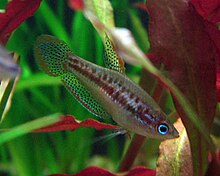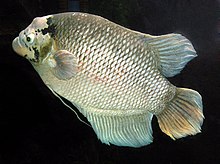Osphronemidae
| Osphronemidae | ||||||||||||
|---|---|---|---|---|---|---|---|---|---|---|---|---|

Dwarf gourami |
||||||||||||
| Systematics | ||||||||||||
|
||||||||||||
| Scientific name | ||||||||||||
| Osphronemidae | ||||||||||||
| Bleeker , 1859 |
The Osphronemidae are the most species-rich family of labyrinth fish (Anabantoidei). In total there are over 130 species, of which over 70 belong to the genus of the fighting fish ( Betta ). All Osphronemidae live in freshwater in slow-flowing rivers, lakes, ponds and floodplains from Pakistan and India to Southeast Asia (west of the Wallace Line and not originally in the Philippines ), eastern China and Korea .
features
Most representatives are small, less than ten centimeters long, the smallest reach just two centimeters, while the largest giant gourami reaches a length of 70 centimeters. The body is elongated or oval, the head large, the lower jaw protruding. In many species, one of the fin rays of the pelvic fins is thread-like drawn out and covered with taste buds. All species have small comb scales that are very close together. The ploughshare and palatine bone are toothless, the organ of the labyrinth is strongly folded. The dorsal fin is short in most cases, while the anal fin is very long. The caudal fin is slightly rounded or forked.
Way of life
The Osphronemidae occur in stagnant or slowly flowing waters, often in heavily weed or oxygen-poor waters. They are diurnal, form small areas and feed mainly on approach food (insects or arachnids that have fallen on the surface of the water), insect larvae and small crustaceans.

Reproduction
All Osphronemidae care for the brood , most of them build a foam nest . The relatively small eggs are lighter than water (swimming eggs) and rise up into the foam nest. The mostly very colorful males or both parents of the foam nest builders take care of the eggs. The giant gouramis build a nest out of plant material and the male takes care of the brood. The majority of the fighting fish ( Betta ), the pointed head gourami ( Ctenops nobilis ), the pike heads ( Luciocephalus ) and chocolate gouramis ( Sphaerichthys ) are mouthbrooders , either the females or the males breed. Since the same reproductive strategies occur in different taxa that are not closely related to one another, they must have evolved independently several times.
Systematics
The family name was established between 1995 and 2006, replacing the name Belontiidae . Under the name Belontiidae the family contained the same genera as under the name Osphronemidae; only the genus Osphronemus was classified in its own family. In addition, the distribution in subfamilies was different. A German name for this family is not used in the literature, even if many representatives have the name component “Gurami”. A specialty is the subfamily name "Macropodusinae" (from Greek: makros (μακρ großς) = large and pus, podos (ποδός) = foot or [pelvic] fin), which should actually be called "Macropodinae", but for the family of the Kangaroos (Macropodidae) is awarded.
The following diagram shows the relationships within the Osphronemidae.
| Osphronemidae |
|
||||||||||||||||||||||||
|
|


The Osphronemidae are divided into five subfamilies with 14 genera and about 135 species.
- Subfamily Belontiinae
Liem , 1963 (2 species)
- Genus Belontia Myers , 1923
- Honeycomb macropod ( Belontia hasselti ( Cuvier , 1831))
- Ceylon macropod ( Belontia signata ( Günther , 1861))
- Genus Belontia Myers , 1923
- Subfamily Osphroneminae Bleeker , 1859 (4 species)
- Genus Giant Gouramis ( Osphronemus Lacépède , 1801)
- Subfamily Luciocephalinae Bleeker , 1860 (17 species)
- Genus Ctenops McClelland , 1845
- Pointed head gourami ( Ctenops nobilis McClelland , 1845)
- Genus pike heads ( Luciocephalus Bleeker , 1851)
- Genus Parasphaerichthys Prashad & Mukerji , 1929
- Parasphaerichthys lineatus Britz & Kottelat , 2002
- Parasphaerichthys ocellatus Prashad & Mukerji , 1929
- Genus Chocolate Gouramis ( Sphaerichthys Canestrini , 1860)
- Pointed-mouthed chocolate gourami ( Sphaerichthys acrostoma Vierke , 1979)
- Chocolate gourami ( Sphaerichthys osphromenoides Canestrini , 1860)
- Sphaerichthys selatanensis Vierke , 1979
- Vaillants Chocolate Gourami ( Sphaerichthys vaillanti Pellegrin , 1930)
- Genus Ctenops McClelland , 1845
- Subfamily threadfish (Trichogastrinae)
- Genus Trichogaster ( Bloch & Schneider , 1801)
- Honey gourami ( Trichogaster chuna ( Hamilton , 1822))
- Striped threadfish ( Trichogaster fasciata Bloch & Schneider , 1801)
- Thick-lipped threadfish ( Trichogaster labiosa Day , 1877)
- Dwarf gourami ( Trichogaster lalia ( Hamilton , 1822))
- Genus Trichopodus Lacépède , 1801
- Mosaic Gourami ( Trichopodus leerii Bleeker , 1852)
- Moonlight gourami ( Trichopodus microlepis ( Günther , 1861))
- Gourdfish ( Trichopodus pectoralis Regan , 1910)
- Trichopodus poptae Low , Tan & Britz , 2014
- Spotted threadfish ( Trichopodus trichopterus ( Pallas , 1770))
- Genus Trichogaster ( Bloch & Schneider , 1801)
- Subfamily Macropodusinae Liem , 1963 (96 species)
- Genus fighting fish ( Betta Bleeker , 1850)
- Genus of paradise fish ( Macropodus Lacépède , 1801)
- Genus Malpulutta Deraniyagala , 1937
- Malpulutta kretseri Deraniyagala , 1937
- Genus licorice gouramis ( Parosphromenus Bleeker , 1877)
- Genus Pseudosphromenus Bleeker , 1879
- Black pointed tail macropod ( Pseudosphromenus cupanus ( Cuvier , 1831))
- Red pointed tail macropod ( Pseudosphromenus dayi ( Köhler , 1908))
- Genus Growling Guramis ( Trichopsis canestrini , 1860)
- Growling dwarf gourami ( Trichopsis pumila Arnold , 1936)
- Schaller's Growling Gurami ( Trichopsis schalleri Ladiges , 1962)
- Growling gourami ( Trichopsis vittata ( Cuvier , 1831))
Tribal history
The fossil record of the osphronemids is extremely sparse. There is only one articulated fossil from the marl of the Sangkarewang Formation (late Eocene to early Oligocene (before 28.5 - 37 million years ago )) from Sumatra . It was assigned to the recent species Osphronemus goramy . At the time of the fossil description , O. goramy was the only Osphronemus species described. Rüber et al. but are of the opinion that it is not possible to assign the fossil to a recent crown group , since the formation of the Osphronemidae, determined with the help of the molecular clock , is suspected in this period.
use
Large species, especially the giant gouramis, serve as food fish , while small, colorful species are popular aquarium fish .
literature
- Kurt Fiedler: Textbook of Special Zoology, Part 2: Fish . 2nd volume. Gustav Fischer Verlag, Jena 1991, ISBN 3-334-00339-6 .
- Joseph S. Nelson : Fishes of the World , John Wiley & Sons, 2006, ISBN 0-471-25031-7 .
- Günther Sterba : The world's freshwater fish. 2nd Edition. Urania, Leipzig / Jena / Berlin 1990, ISBN 3-332-00109-4 .
- Volker Storch & Ulrich Welsch: Systematic Zoology , 6th Edition, Spectrum Academic Publishing House Heidelberg • Berlin, 2004, ISBN 3-8274-1112-2 .
Individual evidence
- ↑ a b c Lukas Rüber, Ralf Britz & Rafael Zardoya: Molecular Phylogenetics and Evolutionary Diversification of Labyrinth Fishes (Perciformes: Anabantoidei). Syst. Biol. 55 (3): 374-397, 2006 ISSN 1063-5157 doi: 10.1080 / 10635150500541664
- ↑ J. Schmidt: New names for subfamilies of the Anabantoidei . In: The Macropod . No. 9/10 , 2006, ISSN 0937-177X , p. 157 ( in the online archive - summary of the scientific publications where “Britz 2005” actually means “Britz 1995”). in the online archive ( Memento of the original from September 1, 2009 in the Internet Archive ) Info: The archive link was inserted automatically and has not yet been checked. Please check the original and archive link according to the instructions and then remove this notice.
- ^ Joseph S. Nelson, Terry C. Grande, Mark VH Wilson: Fishes of the World. Wiley, Hoboken, New Jersey, 2016, ISBN 978-1-118-34233-6 , pages 392-393.
Web links
- Osphronemidae on Fishbase.org (English)



